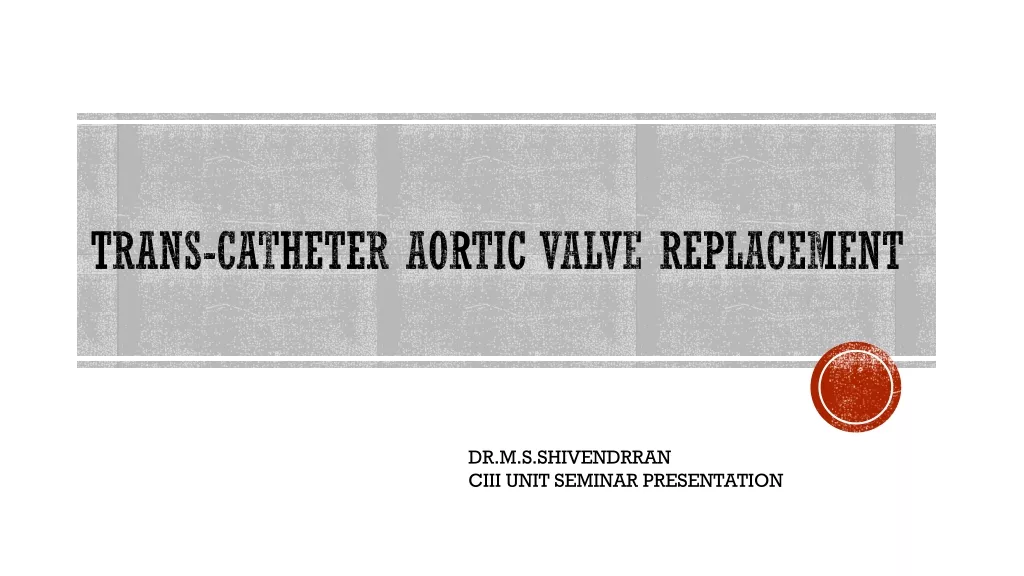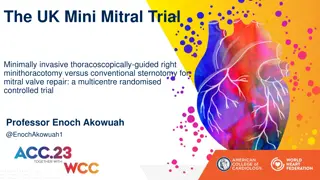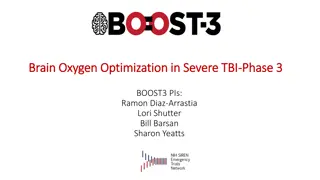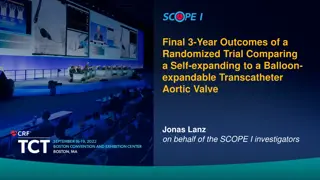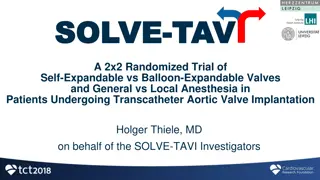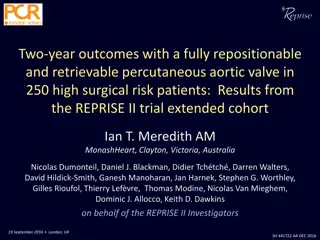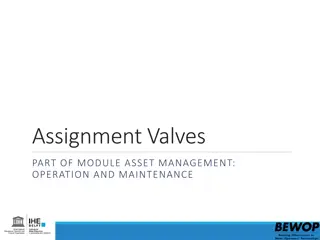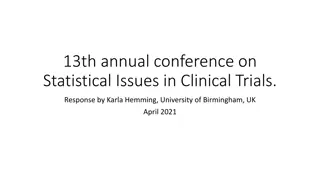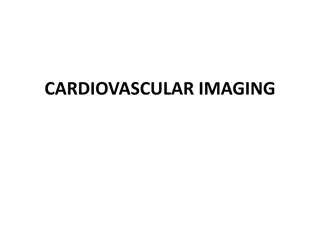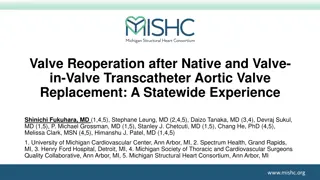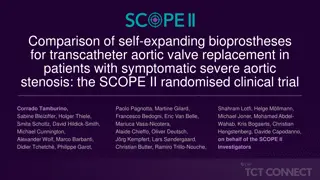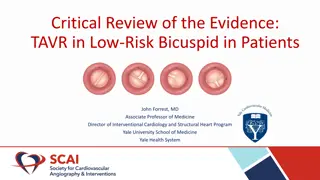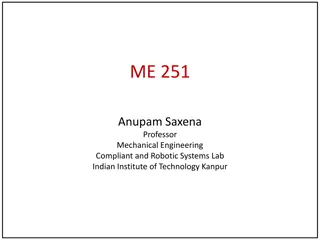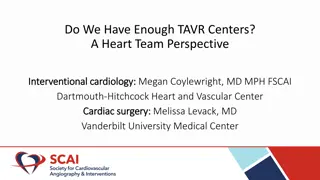Advances in Aortic Valve Development and TAVR Trials
The presentation discusses various endpoints in aortic valve development and Transcatheter Aortic Valve Replacement (TAVR) trials, including comparisons, study stages, and newer devices. It covers different trial populations, primary and secondary endpoints, and the evaluation of non-inferiority. Surrogate endpoints and their pros and cons are also highlighted.
Download Presentation

Please find below an Image/Link to download the presentation.
The content on the website is provided AS IS for your information and personal use only. It may not be sold, licensed, or shared on other websites without obtaining consent from the author. Download presentation by click this link. If you encounter any issues during the download, it is possible that the publisher has removed the file from their server.
E N D
Presentation Transcript
Endpoints for Aortic Valve Development Ori Ben-Yehuda, MD Cardiovascular Research Foundation New York, NY
Disclosure Statement of Financial Interest I, Ori Ben-Yehuda, DO NOT have a financial interest/arrangement or affiliation with one or more organizations that could be perceived as a real or apparent conflict of interest in the context of the subject of this presentation.
TAVR Trials: The Initial Trials Comparison to SAVR High Surgical Risk Intermediate Risk Comparison to medical therapy Inoperable Patients Population with high hard point event rates- mortality and stroke
The Current/Next Stage in TAVR Studies Lower Risk Asymptomatic Earlier in the disease process- moderate AS What are the most relevant endpoints? Can sample size be reduced?
EARLY- TAVR Asymptomatic patients with Severe AS Not a specifically surgically low risk population N=1109 Primary Endpoint: non-hierarchal -all-cause death or stroke or unplanned cardiovascular hospitalization Secondary Endpoint: death or disabling stroke clinicaltrials.gov (NCT03042104)
Partner 3: Low Risk AS patients STS<4 N=1328 patients; randomized to surgery vs. TAVR (transfemoral) Primary Endpoint: All-cause mortality, all stroke, and re-hospitalization This composite endpoint will be evaluated as a non- inferiority analysis based on a relative non-inferiority margin of 35% clinicaltrials.gov (NCT02675114)
Newer Devices- what pathway, what endpoints? Non-inferiority design for total mortality and stroke Reasonable relative margin Secondary endpoints may differentiate among devices Rate of PVL Rate of PPM Vascular Complications (low profile; smaller sheaths, etc )
Surrogate Endpoints Pros s Con s Every patient contributes to endpoint Associated but not necessarily causal with hard endpoints Important endpoints for patients (eg, QoL) Difficult to combine into a composite endpoint Shorter follow-up
Type of Surrogate Endpoints Applicable to TAVR Imaging Echo- Reduction in stenosis, valve regurgitation, etc., EF MRI- Reduction in LVH, Infarct Size Exercise endpoints 6MWT, ETT, CPET Quality of Life Generic- SF-36/SF-12, EQ-5 Disease specific- SAQ, MLWHFQ, KCCQ Biomarkers NT-NBP
Heart Failure Hospitalization Equivalents Okumura et al. Circulation 2016; 133:2254-2262
Heart failure event Symptoms New or Worsening Physical Examination New or Worsening Laboratory Data New or Worsening Criterion for new or worsening symptoms due to HF is to have at least 1 of the following on presentation: Criterion for new or worsening objective findings due to HF includes at least 2 physical examination findings OR 1 physical examination finding and at least 1 laboratory criterion. Physical examination findings include new or worsened: a) Peripheral edema b) Increasing abdominal distention or ascites c) Pulmonary rales/crackles/crepitations d) Increased jugular venous pressure and/or hepatojugular reflux e) S3 gallop f) Clinically significant or rapid weight gain thought to be related to fluid retention Documentation of new or worsening laboratory evidence of HF obtained within 24 h of patient presentation. Criterion for new or worsening objective findings due to HF includes at least 2 physical examination findings OR 1 physical examination finding and at least 1 laboratory criterion. Laboratory criteria include new or worsened: a) Increased BNP/NT-proBNP b) Radiological evidence of pulmonary congestion c) Noninvasive diagnostic evidence of HF d) Invasive diagnostic evidence of HF a) Dyspnea b) Decreased exercise tolerance c) Fatigue d) Worsened end-organ perfusion e) Volume overload 12 Hicks et a. 2017 Cardiovascular and Stroke Endpoint Definitions for Clinical Trials. Circulation. 2018;137:961 972.
TAVR UNLOAD Concept Follow-up: 1, 6 months 1 & 2 years TAVR + OHFT TAVR UNLOAD Trial LV-EF< 50% & Moderate AS R Clinical endpoints Symptoms Echo QoL International Multicenter Randomized OHFT alone Spitzer et al. AHJ 2016;182:80-88
Integrating Surrogates into Composite Endpoints Composite endpoints are problematic- even for hard endpoints eg: Death, Stroke, MI; mortality and hospitalization Even more challenging for surrogate endpoints, esp with hardpoints e.g: hospitalization plus improvement in KCCQ! How does one combine into a single endpoint?
Finkelstein-Schoenfeld Methodology Hierarchal Composite Endpoint Clinically relevant Allows for combination of hard endpoints (mortality, stroke, re-hospitalizations) and softer but clinically relevant endpoints such as QoL and Functional Status
Finkelstein-Schoenfeld Methodology: A solution to the Composite Endpoint Problem Hierarchy created for endpoints May include disparate types- eg mortality and quality of life Each patient in Arm A is compared with each patient in Arm B For each patient comparison and endpoint in the hierarchy a win, loss, or tie is declared If a win (and corresponding loss for the other patient) is declared no need to continue to lower tier in the hierarchy If a tie is declared, one continues to a lower tier Number of wins is counted in each group
TAVR- UNLOAD: FS Methodology Comparison of each potential subject pair (1 from TAVR group and 1 from OHFT) Step 1 If 1 or both subjects die Subject in TAVR group dies first Subject in OHFT group dies first Both subjects die on the same day Step 2 If no ranking yet available Subject in TAVR group suffers a more severe disabling stroke (mRS 2 to 5) Subject in OHFT group suffers a more severe disabling stroke (mRS 2 to 5) Both subjects suffer a disabling stroke of the same severity Step 3 If no ranking yet available Subject in TAVR group suffers the stroke first Subject in OHFT group suffers the stroke first Both subjects suffer a disabling stroke of the same severity on the same day -------------------------------------------------------------------- ------------------------------------ Step 6 If no ranking yet available Subject in TAVR group is in worse KCCQ category at one year** Subject in OHFT group is in worse KCCQ category at one year Both subjects are in same KCCQ category at one year How event is assessed Favors OHFT Favors TAVR Go to step 2 Favors OHFT Favors TAVR Go to step 3 Favors OHFT Favors TAVR Go to step 4 Favors OHFT Favors TAVR Tie




